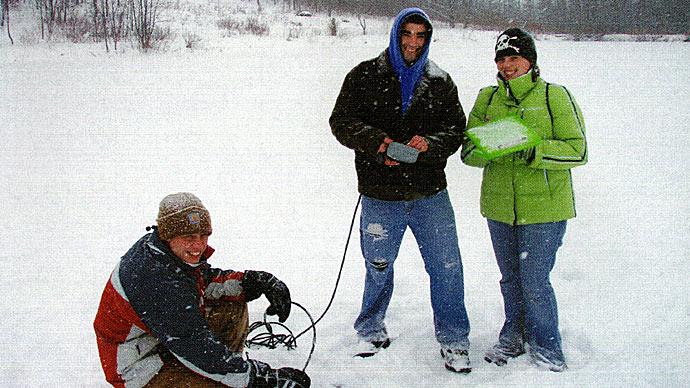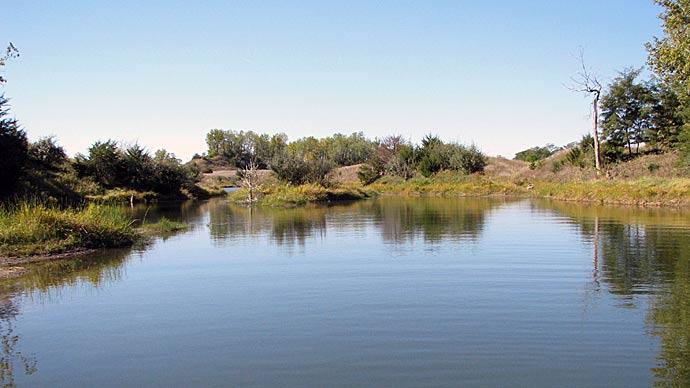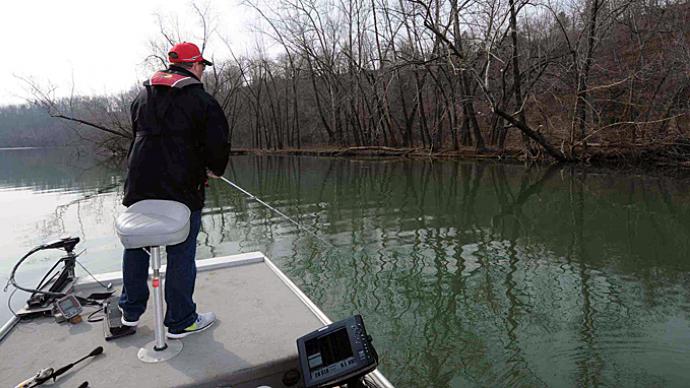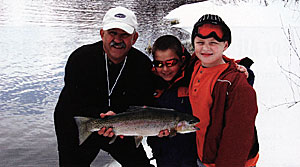
Choosing to be a water guy in an area where visits from Jack Frost in July are normal may seem like self-inflicted torture. From my seat, as long as this chosen climate is despised by rattlesnakes and alligators it's A-OK with me. Old Man Winter really does lay his frozen breath on the Rocky Mountain West hard. Weather can be harsh. High winds, temperatures well below zero and wind chill way below that. In our mountains the temperature doesn't rise to the freezing mark for weeks on end.
Cold means ice. Each year ice cover is an important annual event for our ponds. Last issue we discussed the physical properties of ice and ice formation. But, what happens beneath your pond once that ice forms? Ice puts a lid on the proverbial "pond jar." Even with frigid air temperatures and ice on top of the pond, microbes continue to do what they do, decomposing organic matter. Plankton proliferates, crustaceans and invertebrates sustain, while fish breathe and eat, even though they move slowly due to the fact all pond inhabitants are cold blooded. The pond world continues as it should ... life simply slows down for underwater winters.
Physically, ponds experience "inverse" stratification during winter... meaning cold waters overlay warm waters. Inverse stratification creates considerably different conditions than summer stratification.
Remember this important fact. Water is most dense at 39 degrees F. That means water is its heaviest at that temperature and lighter as it gets colder (and warmer for that matter). That's why ice floats.
In winter, once stratified, water in the pond actually warms under the ice lid. Studies indicate about 70% of the realized winter warming occurs due to absorption of sunlight through the ice. The remaining 30% of warming occurs from water density-sediment decomposition interactions.
It goes like this... water underneath ice exposed to sunlight radiation warms, increasing in density, setting up convection currents. At the same time, warming waters increase in their ability to accept dissolved compounds. Some of these dissolved solids come from the water that froze into ice. These changes continue to increase density, causing affected water to sink, typically into the deepest areas of the pond above decomposing organic sediments. Once overlaying the sediments it creates opportunities for additional warming of sediments. In turn, decomposition rates accelerate. As heat releasing decomposition from chemical and microbial activity occurs, waters continue to warm, allowing increasing acceptance of dissolved compounds. The rate, intensity and duration at which this positive feedback loop operates varies in ponds within a given region. These factors and their effect on release of toxic compounds into bottom waters helps explain why winterkill can occur differentially to similar water bodies proximate to each other or why the same water body experiences annually unpredictable winterkill events.
Sounds complicated, doesn't it?
It really isn't.
The bottom line is this. As decomposition of organic matter is happening, oxygen is taken up. Through clear ice, photosynthesis continues to occur and oxygen levels can increase daily. But, when total oxygen demand of decomposition exceeds dissolved oxygen supply in bottom waters, anoxia, or winterkill, occurs.
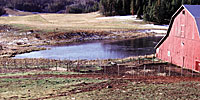
While air-breathing life is extinguished or migrates to more suitable areas in the pond, anaerobic life continues, so water continues to warm. Heating is crucial in determining the outcome, whether a total or partial fish kill occurs. Observations of shallow, perennially ice covered ponds in Antarctica have identified these ponds "burp" methane from active decomposition at rates 63% higher than predicted by models that did not incorporate the effect of under-ice heating and trapping of methane in the ice.
Burping?
Hmmmm ... that's not what we call methane releases in fishing camps I frequent.
Living residents of northern ponds have adapted to winter conditions and ice cover. For example, only in cold environments where full sexual maturity is threatened do plants such as milfoil and pondweeds form vegetative bodies called turions. Turions are leaf covered stem structures formed at the end of the plant which break loose and sink to form new plants in the spring. Turion formation is triggered by the onset of shorter daylight periods and cooling water temperatures. These structures can endure for many years without sexual reproduction. The same species of plants do not form turions when grown in warmer climates.
Microscopic algae proliferates under ice, representing as much as 25% of the total annual primary (plant) production of a pond. The contribution winter algae makes to a pond's annual productivity has much to do with pond size (it diminishes in larger ponds), temperature and under-ice circulation which can remove the algae from the photic zone below the ice. Other important factors include availability of nutrients and the quality of sunlight that penetrates (clear ice vs cloudy ice or winter daylight realized in Colorado vs winter daylight in Alaska).
Fish slow down in a pond in winter. But, there is very little scientific information on activity and preferred behavior of fish under the ice. Lots of different species and literally thousands of different locations means a variety of variables. Perfect conditions for creating scientists that don't agree. Ever seen that?
Besides, who in their right mind would spend time out in the cold trying to understand what fish do in winter?
You guessed it-fisherman, ice fisherman-there are millions of us. Any ice fisherman can tell you fish continue moving, acting normally and feeding despite the fact that the ice cover forms. Interestingly, those studies that have been done agree that fish are very active and that most resident fish do not spend the majority of their time in the warmer bottom waters. Walleyes radio tagged by the In-Fisherman staff in Minnesota left their approximately 1.5 mile summer home ranges in winter and traveled many miles to other areas of the lake in winter. Only one of the three returned to its original home range the next summer. Under ice these fish were often observed in depths of 20 feet or less; well above the deeper, warmer waters. Many biologists believe largemouth bass are completely inactive below 45 degrees, yet we regularly catch bass and channel catfish in Colorado through the ice.
Confounded fish, they never read the "books"!
Based on a lifetime of staring down an 8 inch hole I have concluded not only do fish move regularly in winter, they develop preferences for daily feeding times and temporally adjust forage preferences. This is similar to behavior observed during warmer months, although the triggers and resulting preferences are different. One day there maybe a dawn bite for wax worms and a week later it's an afternoon bite for jigged minnows. If you showed up to fish with tiny wax worms in the summertime you would be laughed out of your fishing club! My experience is that different times require different techniques. Remember, your powers of observation are the foundation of your discoveries.
Water temperature affects nutritional value, digestibility, and growth realized for food ingested by fish. Anyone applying formulated feeds should understand what the temperature thresholds are for the species they are feeding in order to avoid accidentally causing fish to eat more feed than water temperatures will allow them to digest before it goes rancid. If ingested feed goes rancid while still in a fish's stomach ... dead fish! Big problem if you kill a trophy fish that has taken you 3-4 years to grow.
It is important to realize also that the stress level that occurs for fish increases on the cold side of their temperature tolerance range just as it does on the warm side. Care should be taken when handling fish that come from cold waters that approach their tolerance range.
The result of my observations is that often times when feed, natural or formulated, is applied wisely, fish will grow well under the ice. This is especially true for cool and cold water fish species.
Ponds in a temperate climate have needs in winter, perhaps more than in summer. Fresh water, aeration, critters for winter forage, removal of overabundant fish; the list is endless. Under the ice cover there is an entire set of physical and chemical reactions going on that sustains the same biological community that provides you with recreation in summer. When you are tempted to forgo your ponds needs in winter based on the assumption that "not much is going on," I would caution you. If just 10% of you primary productivity occurs in winter it's not hard to see that ignoring your pond's needs in winter reduces your potential for success. When have you had any investment sustain a 10% loss for very long without failing?
Mike Mitchell is Senior Aquatic Biologist for Queen of the River Fisheries, based in Longmont, Colorado.
Reprinted with permission from Pond Boss Magazine

